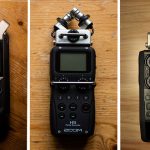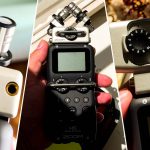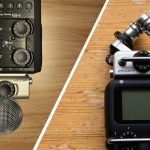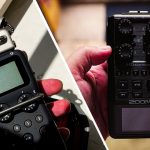So presumably you’ve owned a Zoom H4n Pro for a while now, and you’re looking to upgrade. Maybe you’re thinking about starting a podcast, and you’re wondering what recorder you should buy in order to get started. No matter what the case may be, in this article we’re going to talk about the Zoom H5. I’m going to go over what it can, and can’t do, and who should buy it.

Inputs
The Zoom H5 has two XLR inputs, and a 3.5mm stereo mini-jack input. Simply put, the XLR inputs are for larger microphones, such as the ones you’d use on a podcast, or shotgun mics, which are used to record dialogue in film.
The 3.5mm stereo mini-jack input accepts TS, or TRS plugs. Using the TS plug will give you a mono sound, which is only one track, and which will be present on the left-hand side. If you connect a TRS plug to it, the Zoom H5 will record a stereo signal.
This is useful if you need to plug in a lavalier mic, in order to record dialogue. On the Zoom H5, the 3.5mm input can be found on the side of the X/Y microphone capsule.
Bear in mind that your lav mic might require 2.5V plugin power, which the Zoom H5 can provide. This can be done by going into Menu, In/Out, Plugin Power, and then selecting On. The same applies to Phantom Power, if you’re using a condenser microphone which needs it.
If you have a smartphone lavalier microphone, chances are it has a TRRS plug, which will not work with this recorder.
Alternatively, if you plan on doing journalism, or recording one on one interviews, which would only require a maximum of two external microphones, the two XLR inputs on the Zoom H5 will suffice. In case you plan on recording a podcast, bear in mind the two microphone limitation.
Now, if you need more inputs, you might want to have a look at the Zoom H6 video review above.
Battery Life
According to Zoom, the H5 should be able to run for about 15 hours. Bear in mind that your mileage may vary, as certain variables, such as whether you’re using Phantom Power, can affect how long the recorder can go for.
There are many different variables which could potentially affect the battery life of the device, but the takeaway is that the H5 can record for hours at a time, and It’s always worth carrying some extra batteries with you, just in case.
Given that the Zoom H5 takes two AA batteries, packing a few extra should be enough, depending on what your plans are.
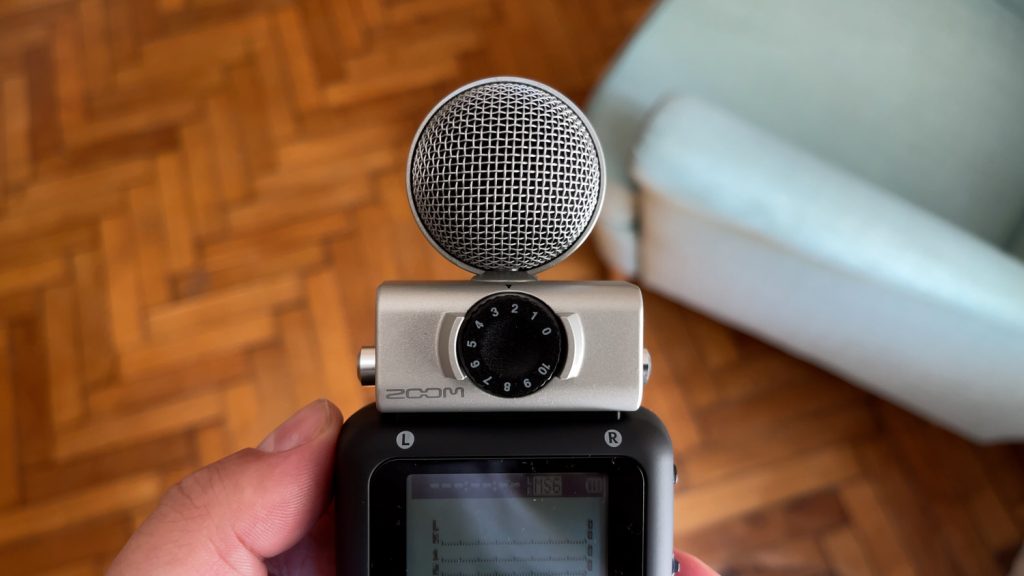
Size & Build
The actual dimensions for the Zoom H5 are 7.77 x 2.63 x 1.66 inches, and it weighs 9.52 oz (269 grams). Even though it is relatively light, it feels sturdy in the hand, and it looks rather rugged.
You should always treat your equipment with care, but I personally wouldn’t be too worried about roughing this recorder up a bit.
Portability
The Zoom H5 is very portable, and it comes with a plastic case, that is cushioned, and compact. This allows you to safely carry your recorder around, whilst not impeding you if you quickly need to take it out and record.
Display
When it comes to its display, the H5 has as a backlit LCD screen. This is great if you’re recording in low light conditions.
If you’re mounting the recorder on a DSLR, the position of the screen could be better. As I’ve said in my Zoom H6 video, manufacturers should start including swivel screens with future iterations of these recorders. This would make them that much more versatile.
Free Sound Effects
By the way, did you know I have compiled the largest list of free sound effects in the world? Over 500GB of sounds, ready to be downloaded, free of charge. Just figured you’d want to know. And now, back to the review.
Sound Quality
In regards to noise, the Zoom H5 has the same preamps as the Zoom H6. No major differences between the two when it comes to audio quality.
When it comes to pre-amps, neither of them are as good as the Sony PCM-D100, though the Sony device does not have XLR inputs, and in either case, the Zoom H5 and Zoom H6 have better pre-amps than the Zoom H4n Pro.
Simply put, when recording quieter sounds, there is less hiss produced as a byproduct when you pump up the gain, compared to the older H4n Pro.
If we’re talking about technical specs, the Zoom H5 can do four-track simultaneous recording, and it can record at up to 24bit/96kHz.
If you’re recording voice, all you need is 24bit/48kHz, but if you want to record some sound effects, being able to do so at 96kHz would offer you more flexibility during post production.
Storage
Whilst the Zoom H5 does not offer any built-in storage, it can record directly to SD and SDHC cards up to 32GB in size. Even if you’re recording at 96kHz, that’s a lot of space for your recordings.
If you’re recording a stereo track, at 24bit/48kHz, 32GB should in theory allow you to record about 2000 minutes, or 33 hours.
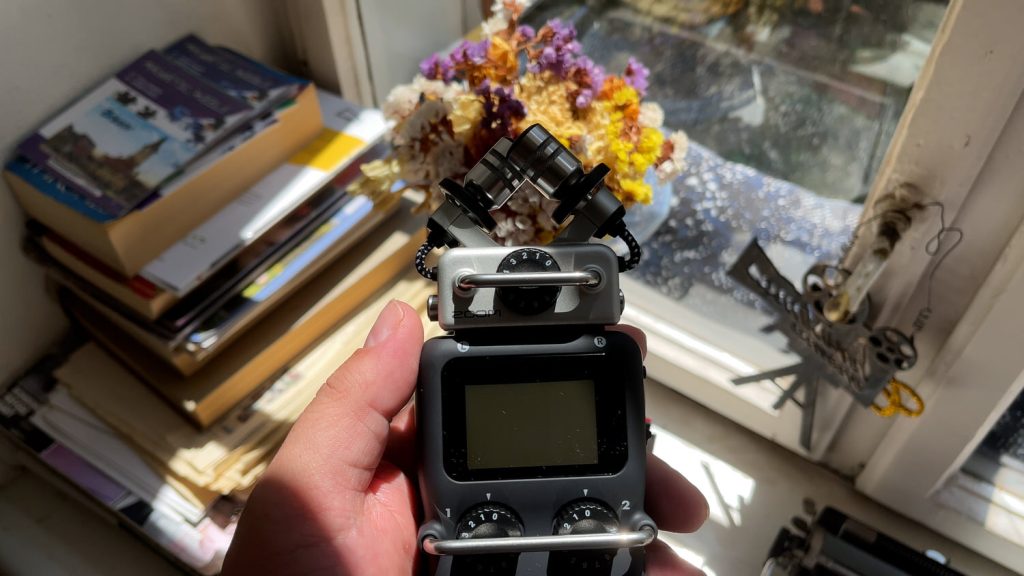
Modularity
Unlike on the Zoom H4n Pro, the Zoom H5 is modular. The X/Y microphone at the top can be easily removed, and replaced with quite a few different types of microphones, as easily as you would swap out a camera lens.
As an added bonus, most of these capsules are also compatible with the Zoom H6. Click here to see all the products I’ve talked about in this article, including a list of the modular microphones you can attach to the Zoom H5.
Versatility
Not only can the H5 be used as a field recorder, but you can also use it as an audio interface. All you need to do is connect it to your computer or laptop via a USB cable, and set it up.
Wind Protection
If you have to record outdoors, which might be the case if you’re a journalist, field recordist, sound effects recordist, if you’re recording a live band, or more, the foam windshield that comes with the recorder will prove itself to be rather unhelpful.
It’s great when recording indoors, but any real gust of wind will make the recording unusable. Luckily, Rycote sells a three-in-one solution for the Zoom H5.
A grip, by which you can hold the recorder, a shock mount which basically eliminates handling noise, and a good quality windshield, which will protect the microphone from wind, though very strong winds might still affect the microphone.
Levels
The Zoom H5 has a metal bar which makes it difficult to accidentally change the input levels. I quite like this, as there is a physical barrier preventing you from accidentally changing anything, which could happen on other recorders.
If you know you’re likely to accidentally hit, or run your hand over the recorder and change the levels, this might be something to take into consideration.
Conclusion
So, should you buy it? The Zoom H5 is modular, rugged, and versatile, with great sound quality and dual XLR inputs. If that’s all you need, the Zoom H5 would be a great investment.
That being said, if you think you might one day need to plug in a few extra microphones, it’s worth spending a little bit of extra money and getting the Zoom H6.
Thank you very much for reading my review of the Zoom H5. I invite you to have a look at some of my other articles. We have something for everyone, whether you’re interested in audio, or cameras and lenses. Alternatively, if you prefer video reviews, feel free to have a look at my YouTube channel.
Product Links
Down below you will find all of the items I talked about in this article.
